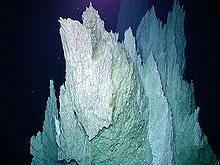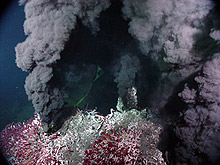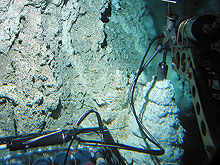
Typical morphology of active chimney at Lost City showing multiple, delicate pinnacles of young carbonate material. Click image for larger view and image credit.
How do the vents at Lost City relate to other hydrothermal vents in the oceans?
David A. Butterfield
JISAO, University of Washington
When the structures at Lost City were first seen in December of 2000, it was clear that they were unlike the features that scientists have been studying since the discovery of the first hydrothermal vents at the Galapagos rift in the late 1970s. What is so different about these vents? How do they fit into the overall picture of hydrothermal venting in the oceans?
The Lost City vents look completely different from mid-ocean ridge volcanic vents. The tall, white, carbonate structures at Lost City emit clear, warm fluids that form no particles in the water. Dark-colored sulfide mineral chimneys that are typical of the mid-ocean ridge emit billowing clouds of black smoke. If you look at this from the perspective of fluid chemistry, the main differences are due to temperature and pH. The fluids coming out of Lost City chimneys have very high pH (10-11) and maximum temperatures of less than 100°C. In contrast, typical smoker vents on the volcanic ridge crests have temperatures of 300 to 400°C, with pH values ranging from 2 to 5. The hotter, acidic fluids on the ridge crest transport very high concentrations of metals like iron, copper, and zinc along with hydrogen sulfide. When this kind of fluid mixes with seawater the result is a black smoke of insoluble metal sulfides. Hot, acidic conditions are required to extract metals like iron, copper and zinc from the rock and carry them in solution. Fluids at Lost City do contain high levels of hydrogen sulfide, but the level of metals is extremely low because of the high pH, so there is no smoke.

Black smokers are not found at Lost City. They are are formed when volcanic action emits metal sulfides, while the calcium carbonate white chimneys at Lost City were formed when fluids with a very high pH and calcium content mixed with seawater. This vigorously venting black smoker, called Sully, emits jets of particle-laden fluids that create the "black smoke". The particles are predominantly very fine-grained sulfide minerals formed when the hot hydrothermal fluids mix with near freezing seawater. Click image for larger view and image credit.
Because the Lost City fluids have very high pH and high calcium content, they cause calcium carbonate to form when they mix with seawater. This is a slower process than formation of the black smoke of metal sulfides. The fluids at Lost City are also not as buoyant as the hot black smoker fluids and the flow of fluids is much slower. The result is a slow but steady growth of white, calcium carbonate minerals, with minor amounts of magnesium hydroxide mixed in. It is not as fast as the growth of metal sulfide chimneys, but the result is just as spectacular.
What causes this difference in fluid chemistry and mineral deposit? The answer lies in what drives the flow of fluids through the ocean crust to form hot springs. There are three essential ingredients to every hot spring: a heat source, a permeable (rock) medium, and a fluid. For almost every case in the ocean, the fluid source is seawater, so that is not a variable here. The rock composition along the volcanic ridge-crest is the relatively constant mid-ocean ridge basalt (MORB) that results from melting of the underlying mantle rocks, and the heat source is generally the magma chamber from which the volcanic rocks are intruded or erupted onto the seafloor. When seawater reacts with hot MORB and approaches equilibrium, the result is a slightly acidic, metal-rich solution. Magmatic gases also escape from the magma chamber and enter the hydrothermal systems, adding to the complexity of volcanic hydrothermal systems.

Water sampler being taken at small chimney on the side of Poseidon.This sampler was developed by David Butterfield to take both water and particulate DNA samples at vent sites. The nozzle is placed over the vent orifice and fluids are sucked into specially designed sterile containers, then brought to the surface for analyses. Click image for larger view and image credit. (HR)
At Lost City and similar environments near slow-spreading ridge-crests, the entire volcanic layer has been essentially scraped away, leaving the underlying mantle rocks exposed to seawater. Hot springs in this environment have a very different rock medium. When seawater reacts with mantle rocks in the process called serpentinization, primary mantle minerals are hydrated, and the result is a high-pH fluid with high levels of reduced gases (hydrogen, methane, hydrogen sulfide) produced by water-rock interaction. At Lost City, there is no indication of a magma chamber to supply heat. Instead, heat must be supplied by the residual heat of the uncovered mantle and by the exothermic serpentinization reactions. Unlike nearly all of the hydrothermal systems previously studied, this one is not driven by volcanic processes.
Our research at Lost City applies many different methods to understand the details of the structure and processes that sustain this kind of hot spring system. What controls the location of carbonate chimneys? How is permeability maintained and what are the fluid pathways? What is the potential impact of these systems on ocean chemistry? Detailed studies at this site, along with exploration, will provide a basis to estimate the global distribution and impact of hydrothermal systems driven by serpentinization.
During the 2005 expedition, we plan to collect a variety of samples from sites that we have previously visited in 2003 and also to expand the geographic coverage to include vents that were not previously sampled. This will give us a better understanding of the fluid pathways and reactions that occur below the seafloor.

























